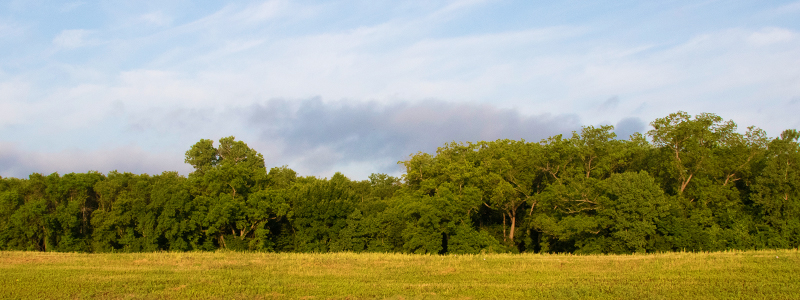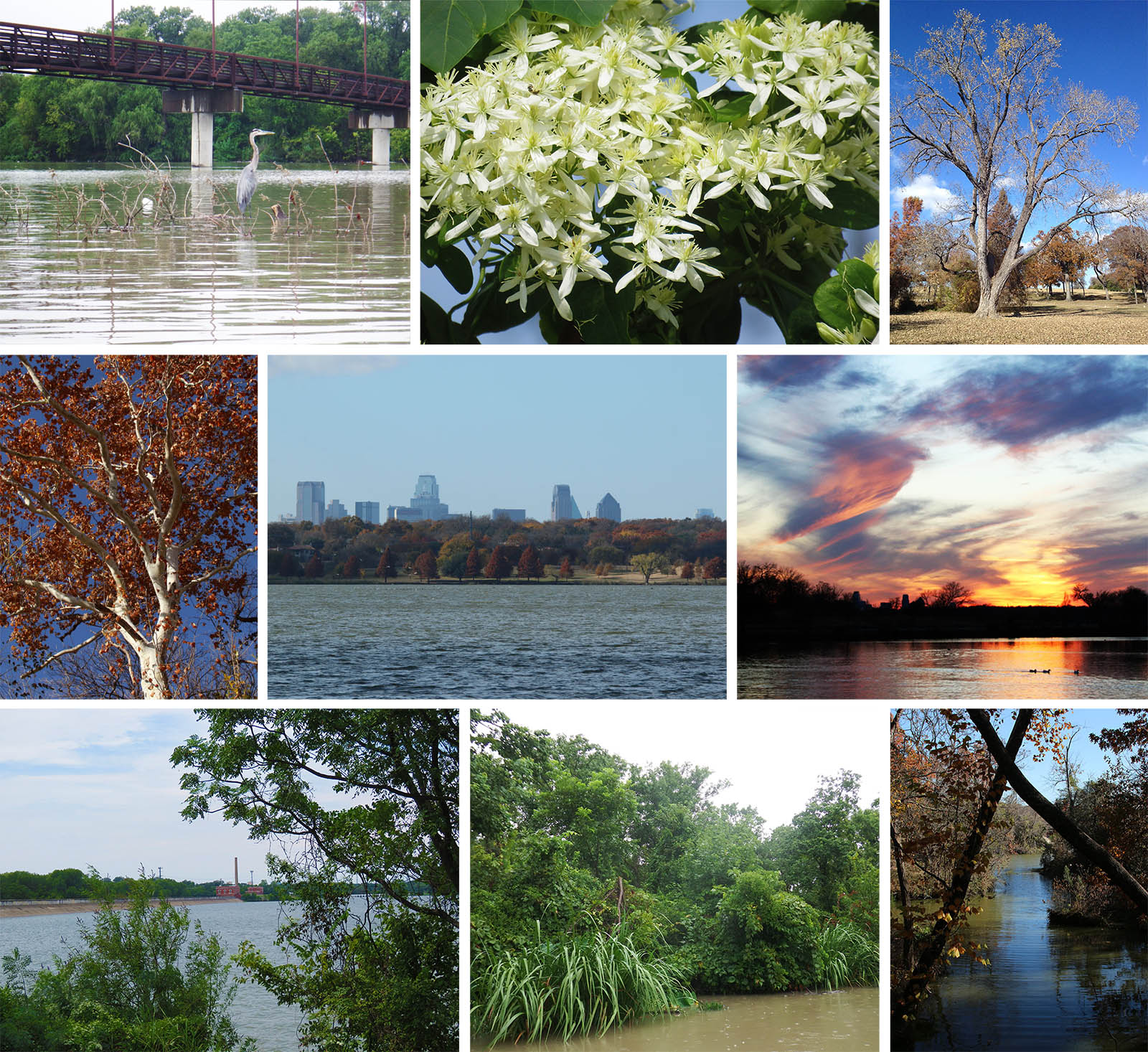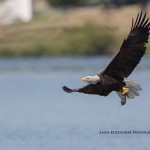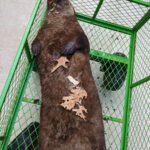There are many creeks and streams that flow across the varied terrains of North Texas. Most all course through neighborhoods and business park for at least part of their run. For a majority of these waterways their ultimate rendezvous is with the Trinity River, or one of its reservoirs. Along the way our creeks may flow over beds of silty black clay, sand, or gravel. Sandstone bases are common. Still other creeks carve out their channels through a bed of white Austin chalk.
North Texas creeks come with a colorful variety of names. Here’s a short list: Prairie Creek, Rowlett Creek, Office Creek, Indian Creek, Furneaux Creek, Denton Creek, Hickory Creek, Timber Creek, Cook’s Branch, Farmer’s Branch, Joe’s Creek, Bachman’s Branch, Dixon Branch, Duck Creek, Muddy Creek, Clear Creek, Cottonwood Creek, Long Branch, Spring Creek, Russel Creek, Pitman Creek, Watter’s Creek, Jackson Branch—to name a few.
Perhaps the best known of all of these is White Rock Creek—the Grande Dame of Dallas-area streams. White Rock Creek is—of course—named for the White Austin Chalk bed it flows through. Here is how The Texas Handbook Online describes this unique waterway:
“White Rock Creek rises two miles southeast of Frisco in southwestern Collin County (at 33°08′ N, 96°47′ W). Intermittent in its upper reaches, the creek follows a southerly course for 23½ miles into White Rock Lake. After the lake it continues south for another eight miles to its mouth on the Trinity River, two miles southeast of where the Interstate Highway 45 crosses the Trinity in Dallas (at 32°43′ N, 96°44′ W). The bed of the creek is composed predominantly of Austin chalk, which weathers, upon exposure, to a tan-white color. Some of the earliest settlements in Dallas County were on the creek, which was known as White Rock Creek by 1844, when the National Road of the Republic of Texas was surveyed across it. Although the creek for most of its course lies within the city of Dallas, the natural vegetation along its bank is undisturbed in many areas, which are generally heavily wooded, mainly with cedar elm, pecan, and ash.”
From its headwaters in Frisco, White Rock Creek follows a string of golf courses, parks, and upper-middle class neighborhoods south through Collin County. Approaching Dallas proper, the creek continues through similar, but older environs. Passing under LBJ Freeway, the creek shares its route with a concrete jogging/biking trail that well-conditioned athletes can follow all the way to White Rock Lake and beyond.
White Rock Lake, which is fed by White Rock Creek and ringed by a narrow buffer of fine parks, is perhaps the crown jewel of the Dallas Park System. Well preserved natural areas, beautiful views, and outstanding recreation are the hallmarks of this lake. We’ll start our tour of White Rock Creek here.
The creek approaches White Rock Lake through a surprisingly wild and isolated corridor. A few months back, back my son and I followed this route into the lake via kayak. It was an overcast and rainy day when we made our trip, adding a bit of murky drama to an already fascinating adventure.
The woods get denser as the creek flows under Loop 12. In some places the vegetation is so thick as to be nearly impassable on foot. But soon, the woods part and the creek widens as it morphs into the north end of White Rock Lake. Here over 1200 acres of water lay between us and the dam/spillway, a little over three miles due south. This is a wonderful urban lake. A real treasure for the residents of Dallas and its suburbs. Wikipedia records the following about its history:
Before it was a lake, White Rock Lake was a collection of farms owned by the Daniel and Cox families. The first record of the Daniel family farm is in the Family Bible of Thomas Walker Daniel. He and his wife Frances Herndon Daniel seem to have moved to the White Rock area in the late 1830s and early 1840s. Daniel’s son had a good friend during the civil war named Cox. When the war was over, the Cox family moved to land adjacent to the Daniel family. Together they had a joint family cemetery called the Daniel-Cox Cemetery. Other pioneer families such as the Humbards, the Glovers, Lavenders, McCommases, Coxes and Donagheys jointly maintained the cemetery.
Construction on White Rock Lake began in 1910 in response to a water shortage in Dallas. After the lake was completed in 1911, residential construction around the lake increased, and in the early 1930s the Dallas Park Board, with the help of the Civilian Conservation Corps, began developing the lakeshores into a municipal park. In 1943 the government used the barracks at Winfrey Point to house German prisoners of war who had served in Rommel’s Afrika Corps. In 1992 White Rock Lake Park was a center of recreational activity for central Dallas, providing picnic areas and bicycle and jogging paths.
As improbable as it may seem today, there was a time when a visit to White Rock Lake would require a drive out of town. Today, even with urban sprawl bastioned only by the thin margin of parkland, White Rock Lake still hosts a wide array of wildlife. Bald Eagles, American White Pelicans, Great Horned Owls, Barred Owls, Coyotes, Bobcats, River Otters, Pileated Wood Peckers, Feral Hogs, and White-tailed Deer have all been seen around the lake. The list goes on and on. Almost every species of wildlife observable in North Texas has been found at White Rock Lake at one time or another. So to have a few very rare visitors like the Long-tailed Duck, the Mandarin Duck, the Horned Grebe, and others.

The White Rock Lake spillway—located in the southeast corner of the lake near the intersection of Garland Road and Winsted Drive—is an interesting place in it own right. Immediately adjacent is the thickly wooded old fish hatchery, which contributes to making this end of the lake an intriguing place for wildlife sightings as well. Bald Eagles, River Otters, and a number of other notable species have been observed here with some regularity.
At the spillway, White Rock Creek roars back to life, flowing over the spillway’s stair steps and then under Garland Road. Beginning again to the south, the creek flows through Tennison Golf Course and under Interstate 30. Next White Rock Creek continues under Military Parkway and Scene Road where it enters Dallas’s famed (infamous) Great Trinity Forest.

The Great Trinity Forest hold 6000 acres real North Texas forests—both old growth and new. Within its boundaries is a place as wild and undeveloped as can be imagined, just a few miles from downtown Dallas. Dense woods and foreboding swamps deny all but the most determined a closeup look at the waters of the creek in this part of the metroplex.
White Rock Creek valley is vast and wide here. The best views of the expansive creek valley are afforded along the Piedmont Ridge trail system on the east side. From there you can experience grand vistas of Great Trinity Forest and beyond.
White Rock Creek continues on past 2nd Avenue and then under C.F. Hawn Freeway where it enters William Blair Park. Cutting through the heart of the park, the creek continues its appointment with the confluence at the mighty Trinity River.
The confluence can be reached on foot, but summer heat and thick vegetation can make the trek demanding. This hike is best attempted in deep fall or winter, but I am hard-headed and we made our attempt in early summer. Pushing through the lush bottomland vegetation made the hike a real adventure. There are no well developed paths leading in to the intersection of White Rock Creek and the Trinity—you have to make your own way. Working off trail only adds to the challenge.

Deep in here is the confluence of White Rock Creek and the Trinity River.
When we arrived at the confluence we were taken aback by the anti-climax. White Rock Creek trickles into the Trinity with a whimper, rather than the bang that might be expected. Along its route through the Great Trinity Forest the creek becomes only a shadow of how it appears around its namesake lake to the north.
Heading back out of the woods, we took a different route. This time we followed the Trinity River north until we picked up the Buckeye Trail. This concrete—but largely unused and over-grown—path leads quickly out of the forest and back to civilization.
Behind us we left a number of trail cameras. The pictures they would record would help complete our exploration of this part of the forest and reveal details about the wildlife that calls this area home. The result was this now famous composite picture of impressive DFW urban wildlife, each standing in roughly the same place, just 5 miles south of downtown Dallas.
Now that we have seen how White Creek ends, let’s look back to where it begins. The genesis of White Rock Creek—like we mentioned earlier—is nearly 32 miles to the north, hidden in a forgotten corner of an otherwise unnotable Frisco subdivision. If we pick up again at White Rock Lake and begin to work our way northward, we still have a Twenty-or-so mile trek against the current before we reach the source of White Rock Creek.
Along the way, White Rock Creek flows through a string of parks and golf courses as it makes its way out of Dallas proper. Olive Shapiro Park, R.P. Brooks Park, Fair Oaks Park, Harry S. Moss Park, and the Royal Oaks Country Club mark the way.
The creek continues under Central Expressway and pushes beneath LBJ Freeway, where it begins again to tie together another long sequence of parks and golf courses like jewels on a beaded necklace.
White Rock Creek traces out of North Dallas and into Plano at George Bush Expressway. Gleneagles Country Club greets the creek here. More parks, golf courses, and upscale neighborhoods escort the waters of White Rock Creek north to Sam Rayburn Parkway. We are only three miles or so from the source at this point.
Throughout its entire northern run, White Rock Creek remains rich in urban wildlife. Bobcats, Coyotes, Beaver, Red-tailed Hawks, Owls, and many other species make use of the bountiful bottomlands to secure their livelihoods. Some of our more adaptable wildlife use the habitats created by the creek as a refuge, all the while leveraging the abundance of the surrounding neighborhoods to augment their survival.

A number of relatively newly built Frisco subdivisions offer the creek company as it winds its way through this part of town. Developers have widened the creek channel and dammed its flow to create small, decorative lakes and water features in a number of these neighborhoods.
White Rock Creek twists and turns abruptly in these subdivisions, morphing into small lakes in some places, and narrowing to small concrete channels in others. And then the queen of all North Texas creeks diminishes abruptly. A short run of concrete directs just a trickle of water out of the darkness of an inconspicuous culvert extruding from under Hillcrest Road. These are the headwaters of White Rock Creek. That’s it. That’s where the wonderful waterway known as White Rock Creek begins—as street runoff in the heart of Frisco, Texas. That’s White Rock Creek—End to End.



















Nice description and commentary, Chris. I remember the northern reaches of White Rock Creek in Dallas County when it was a free flowing, spring fed, fishable stream. My father, brother, and I used to travel north on Central to the stretch near Forest Lane. We caught largemouth and spotted bass, channel and bullhead catfish, white crappie, yellow bass, and various sunfish. Sometimes we’d walk to just upstream or downstream of Central, and fish all night. That was out in the boonies back then, mid to late fifties. Now that stretch, and for a good long distance upstream, runs in concrete channel and is surrounded by central urban development.
I really enjoyed this information on White Rock Creek and Lake. I started exploring it and other urban waterways in the city this Summer and it was great to get some additional information of areas yet to explore.
When Bonnie and I were in Dallas for a few days after Thanksgiving, we stayed in a hotel very near to LBJ and Central Expy. We walked each morning along White Rock Creek, and were pleased that the creek to the north was in its natural channel (though south near Forest Lane and beyond it was in a concrete ditch). Though the riparian woodland was badly littered with flood debris of human origin, the woods itself was in good shape, and had numerous large burr oaks, Texas oaks, and Shumard oaks, some 3 ft diameter. There was also one giant sycamore, multiple trunks with one over 6 ft diameter. Several nice motts of American soapberry. Lots of fox squirrels of course, and we saw one striped skunk, a couple of cottontails, and what we took to be an otter slide, since there was no beaver sign, but there were no otter tracks, either. Lots of coyote sign.
Lots of birds, including double crested cormorant, great blue heron, great egret, snowy egret, mallard, gadwall, northern shoveler, blue winged teal, green winged teal, red tailed hawk, Cooper’s hawk, kestrel, red bellied woodpecker, white breasted nuthatch, Carolina Chickadee, American crow, eastern Phoebe, American robin, northern mockingbird, ruby crowned kinglet, yellow rumped warbler, dark eyed junco, song sparrow, fox sparrow, white crowned sparrow. Most of the ducks were on a shallow pond that looked like it might be an old oxbow, but as it was landscaped, that was not certain.
The creek itself was flowing well with very clear water, but the Austin Chalk bedrock bottom was covered with deep silt in the pools, and even in some runs. Tributaries were flowing well, too, and I attribute that to the generous irrigation that the high rise office, hotel, and apartment buildings practice on their landscapes. We saw no fish, but would not expect many to be evident in winter conditions. Oddly, we saw no minnows, which we usually would expect year round.
All in all, a nice bit of nature in the middle of dense urban development and traffic. My father and I used to fish in this stretch, but mostly nearer to Forest, Central, and Greenville. Back then, it was way out in the boonies.
Thank you for posting, David McNeely. I live along the Jackson Brand of White Rock and regularly walk the trails. I’ve seen many of the same birds you mention, but hadn’t been able to ID all the songbirds. I’ve been intrigued by the call of the chickadee and am glad to put a name to the song.
Along my portion of the creek, the northern shovelers and gadwalls only stick around for a few days in the winter and spring. I just saw my first shovelers of the season this week.
I’ve lived along this part of the creek (near Walnut Hill / Skillman) for two and a half years. Two shallow basins were intentionally dredged along the creek about a decade ago (probably for aesthetics, as a developer had master plans for the area). The creek in this part can be quite moody – perhaps because parts of it have been deviated from the natural bedrock bottom. The silt has built up considerably after the floods this year, creating ‘islands’ that weren’t there before. Another section of the creek had gotten so shallow that carp weren’t able pass – but, that section has since rerouted itself after the last flood and is passable again. You can easily see where there’s bedrock and where the developers dredged here.
I liked reading about visits!
Thank you, Beth!
Thank you for taking the time to write this. I’m going to be living right behind a creek, and I just found out that it’s actually White Rock Creek. It was great to read up on what it really is. It’s fascinating seeing that wildlife and nature hidden behind so much Urban development.
Some more history on White Rock Creek…
https://www.facebook.com/groups/1448880918738775/permalink/1782980211995509/
I would like to know more regarding the portion near Katie Jackson/DORBA park. There seems to be a wall possible dam at on point. And it also appears to have a concrete walkway right down the middle with manhole covers.
Would like to know mOre about this area.
I’m interested in a flood report from yesterday that said white rock creek was going to possibly flood due to rain over the past day or so. It surprised me that flood stage is at about 80 feet and that currently the creek is close to that level. I’m never heard of a creek that is that deep!!! Is this an accurate account from the weather service? Thanks for any info you can provide.
The Houston Chronicle publishes a magazine called Page that contains an article about Dallas-Fort Worth and mentions White Rock Lake. A beautiful body of water is pictured with a waterfall and crystal blue pools of water between outcropping of the white rock. Do you know where that might be and is it swimmable? I wish I could send a picture.
Was kayaking down the creek from above the Lake last Friday after a major rain.
The flow gauge was showing around 150 cfs (felt like a lot more, but the current is slow so idk).
My original plan was to start from Hillcrest, but I decided to check out the possible dam right above Greenville first. Indeed there is an extremely dangerous dam that you can see from the bridge – it is about 2-3 meters high, and the vertical walls built by the country club make it impossible to portage.
So I had to find a place to put in below Greenville. The first place I found was under the bridge at Abrams Rd. There was a bit of flow and some trees across, but nothing major, until right before NW highway – there was a major blockage – multiple trees across the whole stream. Had to paddle back upstream to find a place to get out, and portage about 500 ft. Put in under the NW bridge. After that a smooth ride till the lake. There was another tree which I could kayak under, and one of the bridges i could touch with my hands if I wanted. So at 300+ cfs both would probably be hard to pass safely.
There was a lot of junk floating around, and the water was dirty and a bit smelly. But overall quite an enjoyable kayak ride.